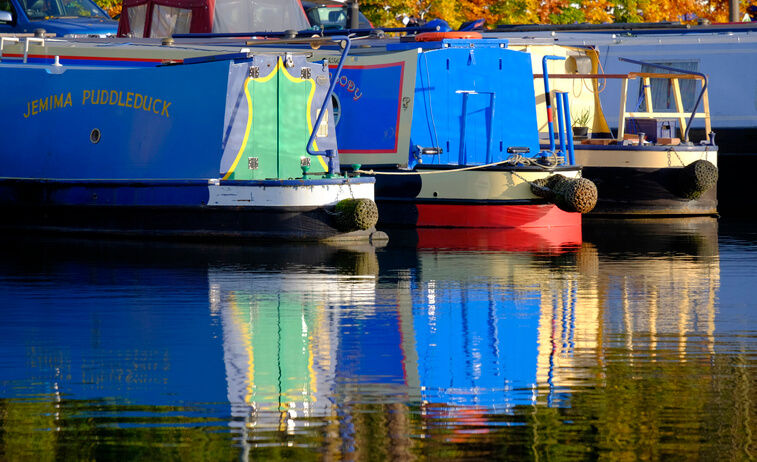A complete guide to narrowboat blacking
25 July 2025

Blacking a narrowboat is an important part of maintaining your vessel and keeping the hull in excellent condition.
In this guide, we discuss what narrowboat blacking is, the many benefits, how to black a narrowboat, and the pros and cons of professional and DIY blacking.
What is narrowboat blacking?
The process of blacking involves applying a protective coating to the hull of a narrowboat to prevent rust and corrosion caused by consistent contact with water. It's an essential part of narrowboat maintenance and comes with a range of benefits.
Why should you black a narrowboat?
Narrowboat blacking has many benefits, including:
- Corrosion protection – Blacking a narrowboat protects its hull from rust caused by being in the water. Without blacking, the hull can quickly degrade, leading to costly repairs and potential safety issues.
- Boosts longevity – It helps to preserve the hull’s structure, which boosts the longevity of the vessel. A well-maintained hull can last decades longer than one that isn’t properly cared for.
- Maintains boat value – When it comes to selling your boat, buyers will be looking for a well-maintained hull. Documenting when you black your narrowboat and providing evidence of this can also help to keep resale value high.
- Opportunity for inspection – Taking a narrowboat out of the water (as required for blacking) provides the opportunity to check the hull for any issues with anodes, the propeller, the rudder, and the weed hatch. This way, problems can be identified and fixed early before they become major issues.
- Improved efficiency – It removes built-up algae and grime that can slow the boat down. A clean, smooth hull reduces drag in the water, which can lessen fuel consumption and make cruising easier.
- Peace of mind – Knowing your hull is protected and in good condition helps you enjoy your vessel with confidence, especially on longer journeys or if you live on your narrowboat
How to black a narrowboat
Blacking is fairly simple. However, precision and attention to detail are important in ensuring the task is completed to a high standard.
1. The boat is taken out of the water, usually into a dry dock or on a slipway, to enable access to the hull
2. The hull should then be pressure washed to remove old paint, algae, and debris. Heated pressure washing is extra effective. This stage is best carried out with two people. One pressure washing while the other follows behind with a scraper to remove stubborn debris.
3. Once the hull is clean, inspect it thoroughly to see if there are any issues that need addressing and make repairs as necessary.
4. Sand the hull to remove the existing coating. This may also uncover any issues that weren’t previously spotted.
5. Paint on a marine-grade primer if you’re using one. A primer isn’t necessary but may extend the life of the coating.
6. Apply the blacking paint and ensure the product is worked into any pits to make sure you achieve a full coverage. Refer to the paint manufacturer’s guidelines to see how long you need to wait before applying the second coat. It’s typically recommended to add a third coat of blacking around the waterline.
How often do you need to black a narrowboat?
How often you need to black a narrowboat depends on whether you use bitumen-based paint or two-pack epoxy. Bitumen paint is the traditional option and more affordable than the alternative. However, it is less durable and typically lasts two to three years. Bitumen brands to consider include Intertuf 16, Rylard Premium Bitumen, and SML Bitumen Paint.
Two-pack epoxy is more expensive but lasts between five and 10 years which makes it a cost-effective option. Products to consider include Jotun Jotamastic 87, Hempel High Protect II, and Rust-Oleum CombiColor 2K Epoxy.
How much does it cost to black a narrowboat?
The cost to black a narrowboat in the UK can vary quite a bit depending on a number of factors, including the size of the boat, the type of coating used, and where you have the work done. It’s cheaper to carry out the task yourself than to get the help of a professional, however, delegating the job to a professional will be less hassle and you can be confident the blacking is being done to the best possible standard.
The price of blacking a narrowboat will typically include:
- Dry dock fees
- Pressure washing of the hull
- Inspection of the hull
- Basic anode replacement where required
- Two or three coats of blacking
Professional vs DIY narrowboat blacking
If you’re unsure whether to hire a professional or black your narrowboat yourself, consider these pros and cons before making your decision:
Professional narrowboat blacking
Pros
- Expertise – The blacking will be applied correctly with attention to detail
- Facilities - Access to dry docks, lifting gear, high-end pressure washers, and professional equipment
- Thorough inspection – Professionals may identify hull issues or wear you might miss
- Insurance approved - Some insurers may prefer professional blacking
Cons
- Cost – Professional blacking can be expensive, especially if two-pack epoxy is used
- Availability – There can be long wait times for a dry dock spot
DIY narrowboat blacking
Pros
- Cost-effective – More affordable if you use bitumen and rent a slipway and equipment
- Gain experience – Learn more about your boat and the blacking process
- Flexibility – You can black your narrowboat at your own convenience (subject to slipway availability)
Cons
- Hard work – Scraping, sanding, painting, and handling heavy gear is very hard work
- Improper application – If it’s not applied correctly, blacking paint may flake, bubble, or fail
- Limited equipment – You may not have access to professional-grade pressure washers
- Weather – Rain or humidity can affect drying times
Should you hire a professional or DIY black your narrowboat?
You may want to hire a professional to black your narrowboat if you’re not confident in your own skills, have limited time, or are simply looking for convenience. However, if you’re on a tight budget, have time to spare, and enjoy carrying out your own narrowboat maintenance, DIY blacking could be the right option for you.
Specialist narrowboat insurance through GJW Direct
Narrowboat blacking can help protect your boat from the financial impact of rust and corrosion, but you may also want to consider narrowboat insurance for an extra layer of protection and peace of mind. Get a quote today to see how much your cover could cost.
Please note the information provided on this page should not be taken as advice and has been written as a matter of opinion. For more on insurance cover and policy wording, see our homepage.
Got a question? Call our UK call centre 0151 473 8000
©Copyright Ripe Thinking Limited 2025. GJWDirect® is a registered trademark and a trading name of Ripe Insurance Services Limited which is Authorised and Regulated by the Financial Conduct Authority No.313411.
Registered office: One Stockport Exchange, Railway Road, Stockport, United Kingdom, SK1 3SW. Registered in England No. 04507332.
